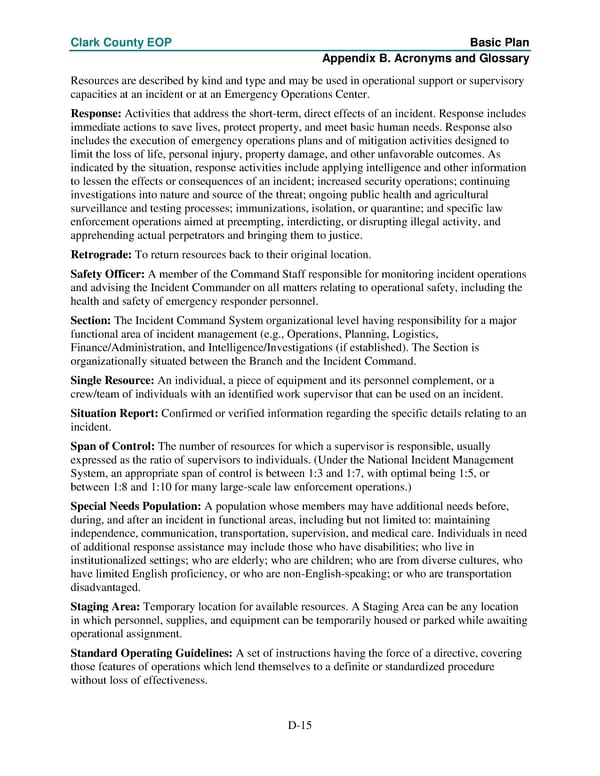Clark County EOP Basic Plan Appendix B. Acronyms and Glossary Resources are described by kind and type and may be used in operational support or supervisory capacities at an incident or at an Emergency Operations Center. Response: Activities that address the short-term, direct effects of an incident. Response includes immediate actions to save lives, protect property, and meet basic human needs. Response also includes the execution of emergency operations plans and of mitigation activities designed to limit the loss of life, personal injury, property damage, and other unfavorable outcomes. As indicated by the situation, response activities include applying intelligence and other information to lessen the effects or consequences of an incident; increased security operations; continuing investigations into nature and source of the threat; ongoing public health and agricultural surveillance and testing processes; immunizations, isolation, or quarantine; and specific law enforcement operations aimed at preempting, interdicting, or disrupting illegal activity, and apprehending actual perpetrators and bringing them to justice. Retrograde: To return resources back to their original location. Safety Officer: A member of the Command Staff responsible for monitoring incident operations and advising the Incident Commander on all matters relating to operational safety, including the health and safety of emergency responder personnel. Section: The Incident Command System organizational level having responsibility for a major functional area of incident management (e.g., Operations, Planning, Logistics, Finance/Administration, and Intelligence/Investigations (if established). The Section is organizationally situated between the Branch and the Incident Command. Single Resource: An individual, a piece of equipment and its personnel complement, or a crew/team of individuals with an identified work supervisor that can be used on an incident. Situation Report: Confirmed or verified information regarding the specific details relating to an incident. Span of Control: The number of resources for which a supervisor is responsible, usually expressed as the ratio of supervisors to individuals. (Under the National Incident Management System, an appropriate span of control is between 1:3 and 1:7, with optimal being 1:5, or between 1:8 and 1:10 for many large-scale law enforcement operations.) Special Needs Population: A population whose members may have additional needs before, during, and after an incident in functional areas, including but not limited to: maintaining independence, communication, transportation, supervision, and medical care. Individuals in need of additional response assistance may include those who have disabilities; who live in institutionalized settings; who are elderly; who are children; who are from diverse cultures, who have limited English proficiency, or who are non-English-speaking; or who are transportation disadvantaged. Staging Area: Temporary location for available resources. A Staging Area can be any location in which personnel, supplies, and equipment can be temporarily housed or parked while awaiting operational assignment. Standard Operating Guidelines: A set of instructions having the force of a directive, covering those features of operations which lend themselves to a definite or standardized procedure without loss of effectiveness. D-15
 Emergency Operations Plan Page 118 Page 120
Emergency Operations Plan Page 118 Page 120